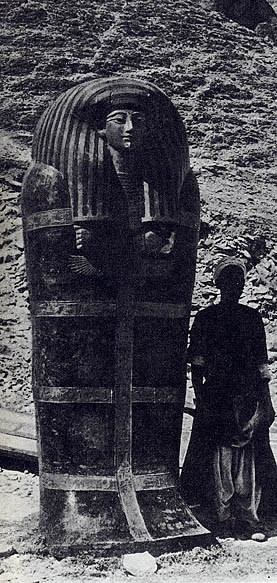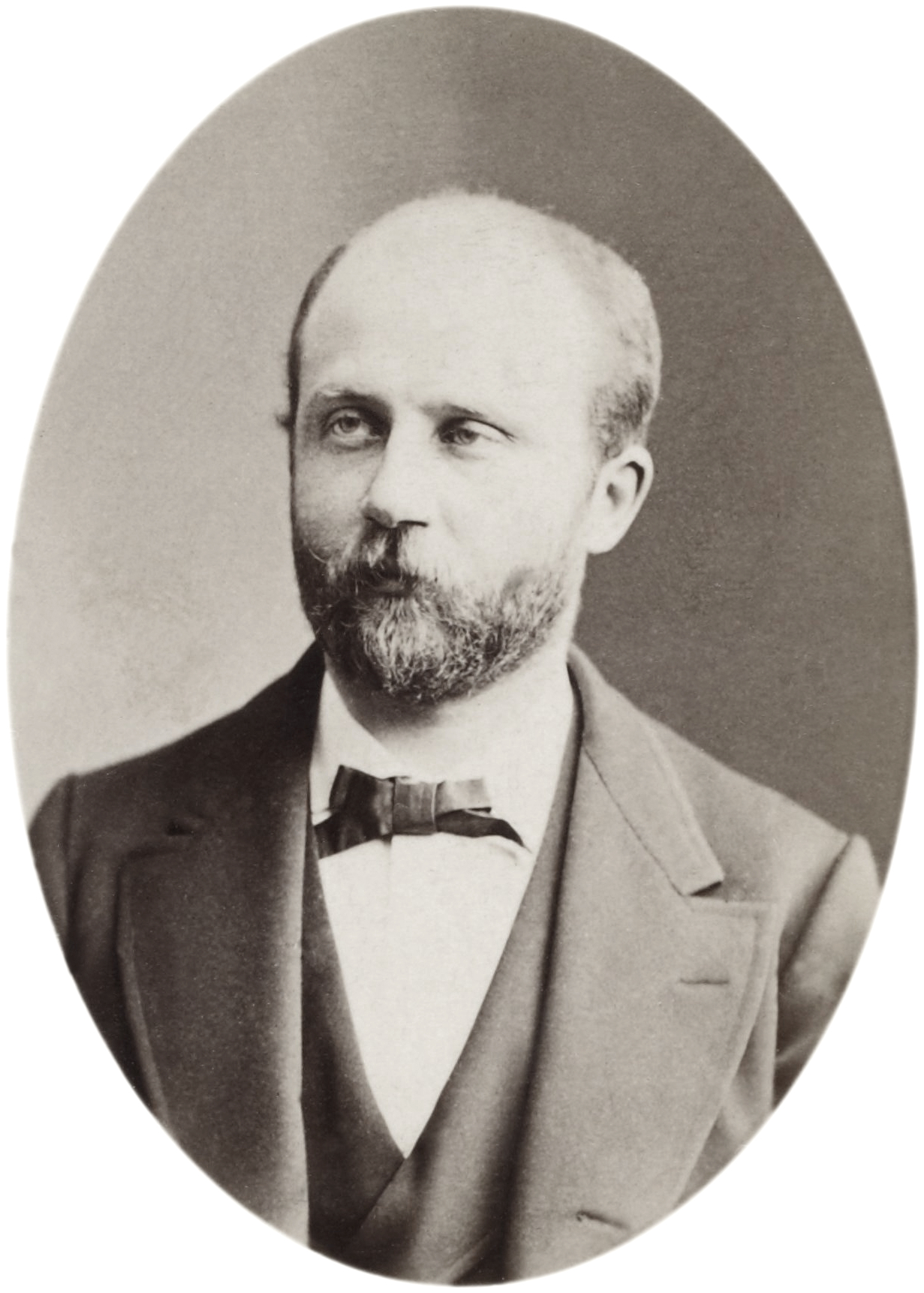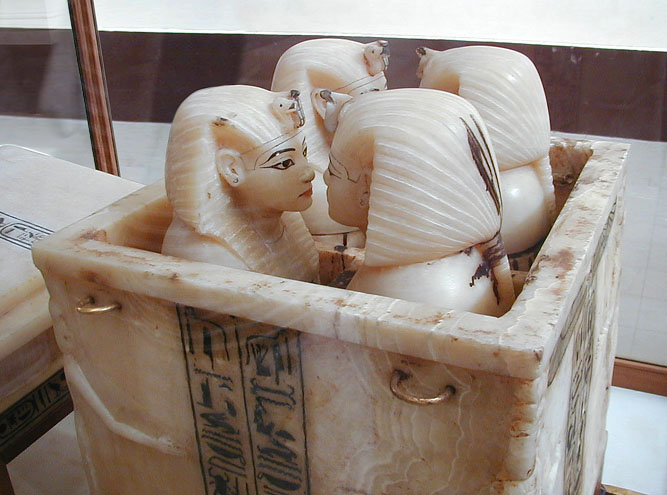|
Tomb Of Yuya And Thuya
Tomb KV46 in the Valley of the Kings is the tomb of the ancient Egyptian noble Yuya and his wife Thuya, the parents of Queen Tiye and Anen. It was discovered in February 1905 by Chief Inspector of Antiquities James E. Quibell, excavating under the sponsorship of American millionaire Theodore M. Davis. Despite robberies in antiquity, the undecorated tomb preserved a great deal of its original contents including chests, beds, chairs, a chariot, and numerous storage jars. Additionally, the riffled but undamaged mummies of Yuya and Thuya were found within their disturbed coffin sets. Prior to the discovery of the tomb of Tutankhamun, this was considered to be one of the greatest discoveries in Egyptology. Layout KV46 consists of a fifteen-step staircase leading to a descending corridor, a further set of short stairs, a second corridor with stairs and niches, and a rectangular burial chamber, the western third of which is deeper than the rest of the floor. The walls of the tomb are not ... [...More Info...] [...Related Items...] OR: [Wikipedia] [Google] [Baidu] |
Yuya
Yuya (sometimes Iouiya, or Yuaa, also known as Yaa, Ya, Yiya, Yayi, Yu, Yuyu, Yaya, Yiay, Yia, and Yuy) was a powerful ancient Egyptian courtier during the Eighteenth Dynasty of Egypt (circa 1390 BC). He was married to Thuya, an Egyptian noblewoman associated with the royal family, who held high offices in the governmental and religious hierarchies. Their daughter, Tiye, became the Great Royal Wife of Amenhotep III. Yuya and Thuya are known to have had a son named Anen, who carried the titles "Chancellor of Lower Egypt", "Second Prophet of Amun", "Sm-priest of Heliopolis", and "Divine Father". They may also have been the parents of Ay,Rice, p.222 an Egyptian courtier active during the reign of Akhenaten, who eventually became pharaoh as ''Kheperkheprure Ay''. There is no conclusive evidence, however, regarding the kinship of Yuya and Ay, although certainly both men came from the town of Akhmim. The tomb of Yuya and Thuya was, until the discovery of Tutankhamun's, one of th ... [...More Info...] [...Related Items...] OR: [Wikipedia] [Google] [Baidu] |
Gaston Maspero
Sir Gaston Camille Charles Maspero (23 June 1846 – 30 June 1916) was a French Egyptologist known for popularizing the term "Sea Peoples" in an 1881 paper. Maspero's son, Henri Maspero, became a notable sinologist and scholar of East Asia. Early life Gaston Maspero was born in Paris in 1846 to Adela Evelina Maspero, born in Milan in 1822, daughter of a Milanese printer, and of an unnamed father, but identified by family tradition with Camillo Marsuzi de Aguirre, Italian revolutionary on the run. He was educated at the Lycee Louis-le-Grand, Jesuit boarding school and university at the ''École normale''. While at school he showed a special taste for history and became interested in Egypt following a visit to the Egyptian galleries of the Louvre at the age of fourteen. At university he excelled in Sanskrit as well as hieroglyphics. It was while Maspero was in final year at the ''École normale'' in 1867 that friends mentioned his skills at reading hieroglyphics to Egyptologi ... [...More Info...] [...Related Items...] OR: [Wikipedia] [Google] [Baidu] |
Throne Of Princess Sitamun
The Throne of Princess Sitamun is an artefact from the tomb of Yuya and Thuya, which belonged to their granddaughter, Princess Sitamun, the daughter of Pharaoh Amenhotep III and Queen Tiye of the 18th Dynasty. Description The wooden throne is an example of the subtlety and elegance of Egyptian woodwork in the 18th Dynasty. It is made from a common wood covered in parts by a thick veneer of a less common wood, possibly walnut. The veneer is attached by pegs. The legs, of solid walnut, are shaped like the front and rear legs of a lion, complete with four toes and a dewclaw on the front feet. These paws sit atop high, ridged, drum bases on which traces of stucco, linen, and silver leaf survive. Cross bars which were originally silver-plated strengthen the legs. The ends of these bars are gilt and shaped like stylised papyrus umbels. A curved support strut under the seat further strengthen the frame. The very well preserved seat is made of fine string threaded through holes i ... [...More Info...] [...Related Items...] OR: [Wikipedia] [Google] [Baidu] |
Eugénie De Montijo
''Doña'' María Eugenia Ignacia Agustina de Palafox y Kirkpatrick, 19th Countess of Teba, 16th Marchioness of Ardales (5 May 1826 – 11 July 1920), known as Eugénie de Montijo (), was Empress of the French from her marriage to Emperor Napoleon III on 30 January 1853 until the Emperor was overthrown on 4 September 1870. Born to prominent Spanish nobility, Eugénie was educated in France, Spain, and England. As Empress, she used her influence to champion "authoritarian and clerical policies"; her involvement in politics earned her much criticism from contemporaries.McQueen, 2011; p. 3 Napoléon and Eugénie had one child together, Napoléon, Prince Imperial (1856–79). After the fall of the Empire, the three lived in exile in England; Eugénie outlived both her husband and son and spent the remainder of her life working to commemorate their memories and the memory of the Second Empire. Youth The woman who became the last Empress of the French was born in Granada, Spain, t ... [...More Info...] [...Related Items...] OR: [Wikipedia] [Google] [Baidu] |
Nile
The Nile, , Bohairic , lg, Kiira , Nobiin language, Nobiin: Áman Dawū is a major north-flowing river in northeastern Africa. It flows into the Mediterranean Sea. The Nile is the longest river in Africa and has historically been considered the List of rivers by length, longest river in the world, though this has been contested by research suggesting that the Amazon River is slightly longer.Amazon Longer Than Nile River, Scientists Say Of the world's major rivers, the Nile is one of the smallest, as measured by annual flow in cubic metres of water. About long, its drainage basin covers eleven countries: the Democratic Republic of the Congo, Tanzania, Burundi, Rwanda, Uganda, Kenya, Ethiopia, Erit ... [...More Info...] [...Related Items...] OR: [Wikipedia] [Google] [Baidu] |
Cairo
Cairo ( ; ar, القاهرة, al-Qāhirah, ) is the capital of Egypt and its largest city, home to 10 million people. It is also part of the largest urban agglomeration in Africa, the Arab world and the Middle East: The Greater Cairo metropolitan area, with a population of 21.9 million, is the 12th-largest in the world by population. Cairo is associated with ancient Egypt, as the Giza pyramid complex and the ancient cities of Memphis and Heliopolis are located in its geographical area. Located near the Nile Delta, the city first developed as Fustat, a settlement founded after the Muslim conquest of Egypt in 640 next to an existing ancient Roman fortress, Babylon. Under the Fatimid dynasty a new city, ''al-Qāhirah'', was founded nearby in 969. It later superseded Fustat as the main urban centre during the Ayyubid and Mamluk periods (12th–16th centuries). Cairo has long been a centre of the region's political and cultural life, and is titled "the city of a thousand m ... [...More Info...] [...Related Items...] OR: [Wikipedia] [Google] [Baidu] |
Egyptian Museum
The Museum of Egyptian Antiquities, known commonly as the Egyptian Museum or the Cairo Museum, in Cairo, Egypt, is home to an extensive collection of ancient Egyptian antiquities. It has 120,000 items, with a representative amount on display and the remainder in storerooms. Built in 1901 by the Italian construction company, Garozzo-Zaffarani, to a design by the French architect Marcel Dourgnon, the edifice is one of the largest museums in the region. As of March 2019, the museum was open to the public. In 2022, the museum is due to be superseded by the newer and larger Grand Egyptian Museum at Giza. History The Egyptian Museum of Antiquities contains many important pieces of ancient Egyptian history. It houses the world's largest collection of Pharaonic antiquities. The Egyptian government established the museum built in 1835 near the Ezbekieh Garden and later moved to the Cairo Citadel. In 1855, Archduke Maximilian of Austria was given all of the artifacts by the Egyptian ... [...More Info...] [...Related Items...] OR: [Wikipedia] [Google] [Baidu] |
Mummy
A mummy is a dead human or an animal whose soft tissues and organs have been preserved by either intentional or accidental exposure to chemicals, extreme cold, very low humidity, or lack of air, so that the recovered body does not decay further if kept in cool and dry conditions. Some authorities restrict the use of the term to bodies deliberately embalmed with chemicals, but the use of the word to cover accidentally desiccated bodies goes back to at least 1615 AD (see the section Etymology and meaning). Mummies of humans and animals have been found on every continent, both as a result of natural preservation through unusual conditions, and as cultural artifacts. Over one million animal mummies have been found in Egypt, many of which are cats. Many of the Egyptian animal mummies are sacred ibis, and radiocarbon dating suggests the Egyptian Ibis mummies that have been analyzed were from time frame that falls between approximately 450 and 250 BC. In addition to the mummies ... [...More Info...] [...Related Items...] OR: [Wikipedia] [Google] [Baidu] |
Canopic Chest
Canopic chests are cases used by ancient Egyptians to contain the internal organs removed during the process of mummification. Once canopic jars began to be used in the late Fourth Dynasty, the jars were placed within canopic chests. Although the first proven canopic burials date from the Fourth Dynasty reign of Sneferu, there is evidence to suggest that there were canopic installations at Saqqara dating from the Second Dynasty.Dodson, Aidan, "Canopic Jars and Chests", in Redford, Donald B. (ed) (2001). ''The Oxford Encyclopedia of Ancient Egypt'', vol. II, Oxford University Press. pp. 231–235 Connections to Ancient Egyptian culture Canopic chests had an important place in Egyptian culture. Canopic chests contained the internal organs (viscera) of mummies, so they relate to the Egyptian belief that the afterlife is just as important as life on earth. Egyptians believed that everything had to be perfectly preserved to journey into the land after life and as part of the mummifi ... [...More Info...] [...Related Items...] OR: [Wikipedia] [Google] [Baidu] |
Silvered
Silvering is the chemical process of coating a non-conductive substrate such as glass with a reflective substance, to produce a mirror. While the metal is often silver, the term is used for the application of any reflective metal. Process Most common household mirrors are "back-silvered" or "second-surface", meaning that the light reaches the reflective layer after passing through the glass. A protective layer of paint is usually applied to protect the back side of the reflective surface . This arrangement protects the fragile reflective layer from corrosion, scratches, and other damage. However, the glass layer may absorb some of the light and cause distortions and optical aberrations due to refraction at the front surface, and multiple additional reflections on it, giving rise to "ghost images" (although some optical mirrors such as Mangins, take advantage of it). Therefore, precision optical mirrors normally are "front-silvered" or " first-surface", meaning that the refl ... [...More Info...] [...Related Items...] OR: [Wikipedia] [Google] [Baidu] |
Gilded
Gilding is a decorative technique for applying a very thin coating of gold over solid surfaces such as metal (most common), wood, porcelain, or stone. A gilded object is also described as "gilt". Where metal is gilded, the metal below was traditionally silver in the West, to make silver-gilt (or ''vermeil'') objects, but gilt-bronze is commonly used in China, and also called ormolu if it is Western. Methods of gilding include hand application and gluing, typically of gold leaf, chemical gilding, and electroplating, the last also called gold plating. Parcel-gilt (partial gilt) objects are only gilded over part of their surfaces. This may mean that all of the inside, and none of the outside, of a chalice or similar vessel is gilded, or that patterns or images are made up by using a combination of gilt and ungilted areas. Gilding gives an object a gold appearance at a fraction of the cost of creating a solid gold object. In addition, a solid gold piece would often be too soft o ... [...More Info...] [...Related Items...] OR: [Wikipedia] [Google] [Baidu] |
Sarcophagi
A sarcophagus (plural sarcophagi or sarcophaguses) is a box-like funeral receptacle for a cadaver, corpse, most commonly carved in stone, and usually displayed above ground, though it may also be buried. The word ''sarcophagus'' comes from the Greek language, Greek Wiktionary:σάρξ, σάρξ ' meaning "flesh", and Wiktionary:φαγεῖν, φαγεῖν ' meaning "to eat"; hence ''sarcophagus'' means "flesh-eating", from the phrase ''lithos sarkophagos'' (Wiktionary:λίθος, λίθος Wiktionary:σαρκοφάγος, σαρκοφάγος), "flesh-eating stone". The word also came to refer to a particular kind of limestone that was thought to rapidly facilitate the decomposition of the flesh of corpses contained within it due to the chemical properties of the limestone itself. History of the sarcophagus Sarcophagi were most often designed to remain above ground. The earliest stone sarcophagi were used by Egyptian pharaohs of the 3rd dynasty, which reigned from about ... [...More Info...] [...Related Items...] OR: [Wikipedia] [Google] [Baidu] |











